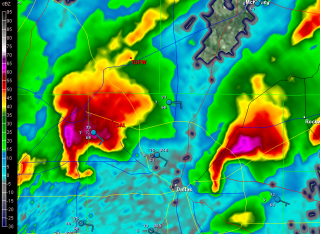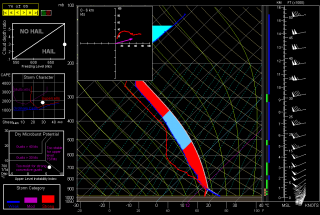Now that all the excitement is over, here are a couple radar grabs from shortly after 3:00 p.m. EST (1903z) of two tornadic supercells moving across Dallas. Click on the images to enlarge them.
I was on the phone with my brother Brian at the time when I took the screenshots. He, my sister-in-law, Cheryl, and my nephew, Sam, live on the eastern side of Dallas. Worried about their safety, I gave Brian a call. It occurred to me that, once the storms had passed, Brian might enjoy seeing a couple of the radar shots that had prompted my concern.
The storms fired when moist, easterly surface winds collided with an old, eastward-moving outflow boundary. There’s plenty of lift and helicity in that combination, and with good instability and adequate upper-air support, supercells and tornadoes were the result. The event was extremely well-covered, as you’d expect when a major city is in the crosshairs in this age of live streaming and hi-def camcorders. Facebook was abuzz with chatter and images as the scenario unfolded.
But it’s all finished, and now we wait for official surveys to fill us in on the full scope of storm damage. From the videos and photos I’ve seen, some of the tornadoes were quite large, but for all that, it sounds like their impact was relatively minor. Of course, in the neighborhoods where homes got damaged or destroyed, it was calamitous, but considering what could have been, Dallas suffered a flesh wound, not a severed limb. So far I haven’t heard reports of any injuries or fatalities; let’s hope that continues to be the case.
One irony of this event is that it falls on a date that affords ample grounds for comparison. Thirty-eight years ago on April 3–4, the infamous 1974 Super Outbreak claimed 319 lives, a figure only recently surpassed by last year’s devastating April 27-28 Super Outbreak. One hundred forty-eight tornadoes raked a thirteen-state region in the East and South, and out of that number, six tornadoes were rated an F5 and twenty-four, an F4. Even the 2011 Southern Outbreak, violent, deadly, and prolific as it was, didn’t rival that statistic, although it certainly came very close.
Dallas today saw nothing like the disasters that unfolded back then in Xenia, Ohio; or Brandenberg and Louisville, Kentucky; or Monticello, Indiana; or Guin, Alabama. That’s a good thing. Such benchmarks are not the kind you ever want your own town to challenge, particularly if your town is as large and populous as Fort Worth or Dallas.
If you want to get a fascinating and gripping retrospective on one facet of the 1974 Super Outbreak, spend a little time listening to these recordings of the blow-by-blow radio reportage from WHAS as the Louisville tornado moved through the city.
Or for a really eerie experience, turn up the volume and listen to this MP3 of the Xenia, Ohio, tornado as it approached and ultimately destroyed the apartment of a Xenia resident, who wisely abandoned his cassette recorder to seek shelter in the basement.
And that’s enough of that. It’s time for me to pull away from the computer and go practice my saxophone.







